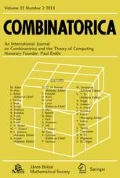Let X = {1, . . . , n}, and let \( {\user1{A}} \) be a family of subsets of X. Given the size of \( {\user1{A}} \), at least how many pairs of elements of \( {\user1{A}} \) must be disjoint? In this paper we give a lower bound for the number of disjoint pairs in \( {\user1{A}} \). The bound we obtain is essentially best possible. In particular, we give a new proof of a result of Frankl and of Ahlswede, that if \( {\user1{A}} \) satisfies \( {\left| {\user1{A}} \right|} = {\left| {X^{{{\left( { \geqslant r} \right)}}} } \right|} \) then \( {\user1{A}} \) contains at least as many disjoint pairs as X (≥r).
The situation is rather different if we restrict our attention to \( {\user1{A}} \subset X^{{{\left( r \right)}}} \): then we are asking for the minimum number of edges spanned by a subset of the Kneser graph of given size. We make a conjecture on this lower bound, and disprove a related conjecture of Poljak and Tuza on the largest bipartite subgraph of the Kneser graph.
Similar content being viewed by others
Author information
Authors and Affiliations
Corresponding author
Additional information
* Research partially supported by NSF grant DMS-9971788




